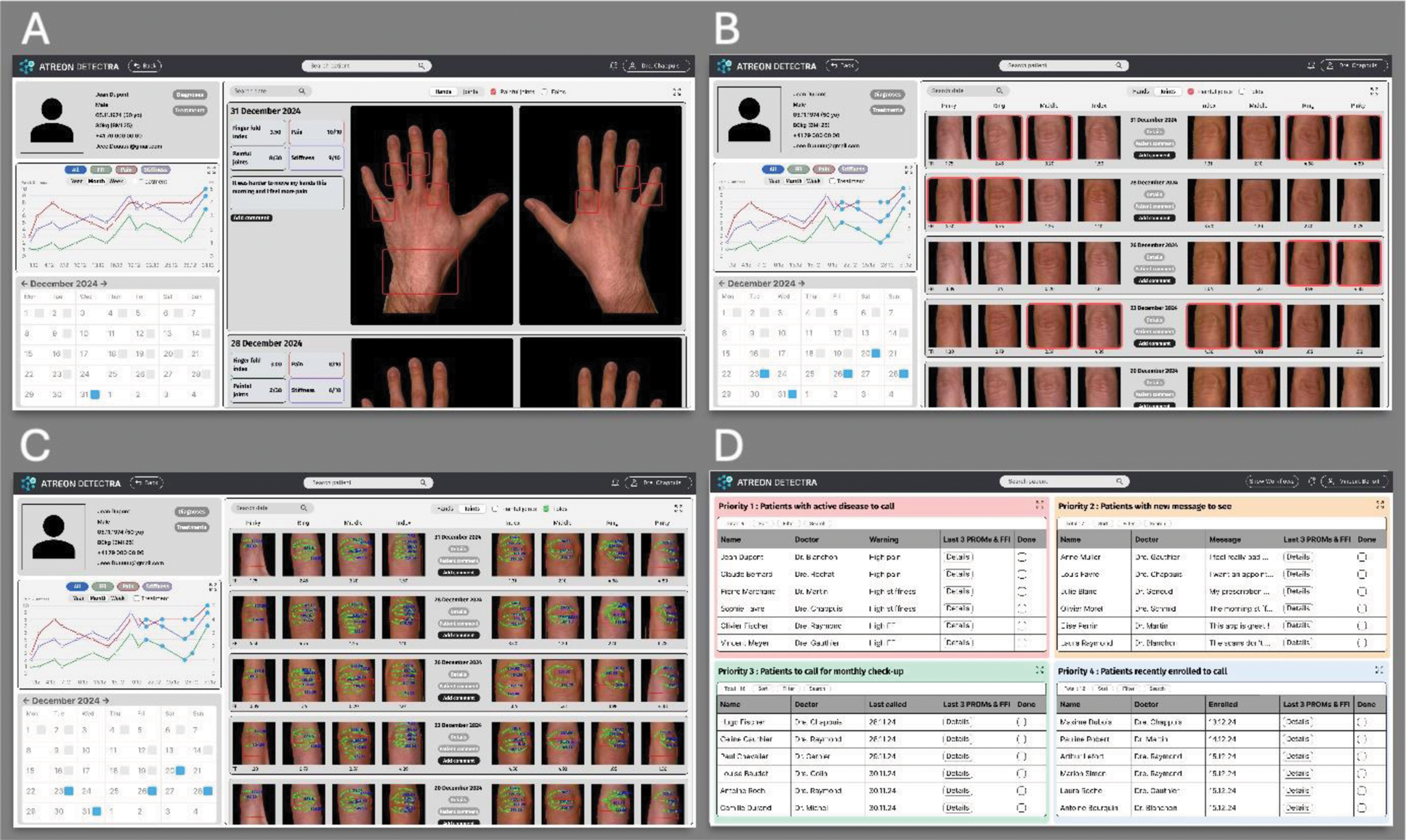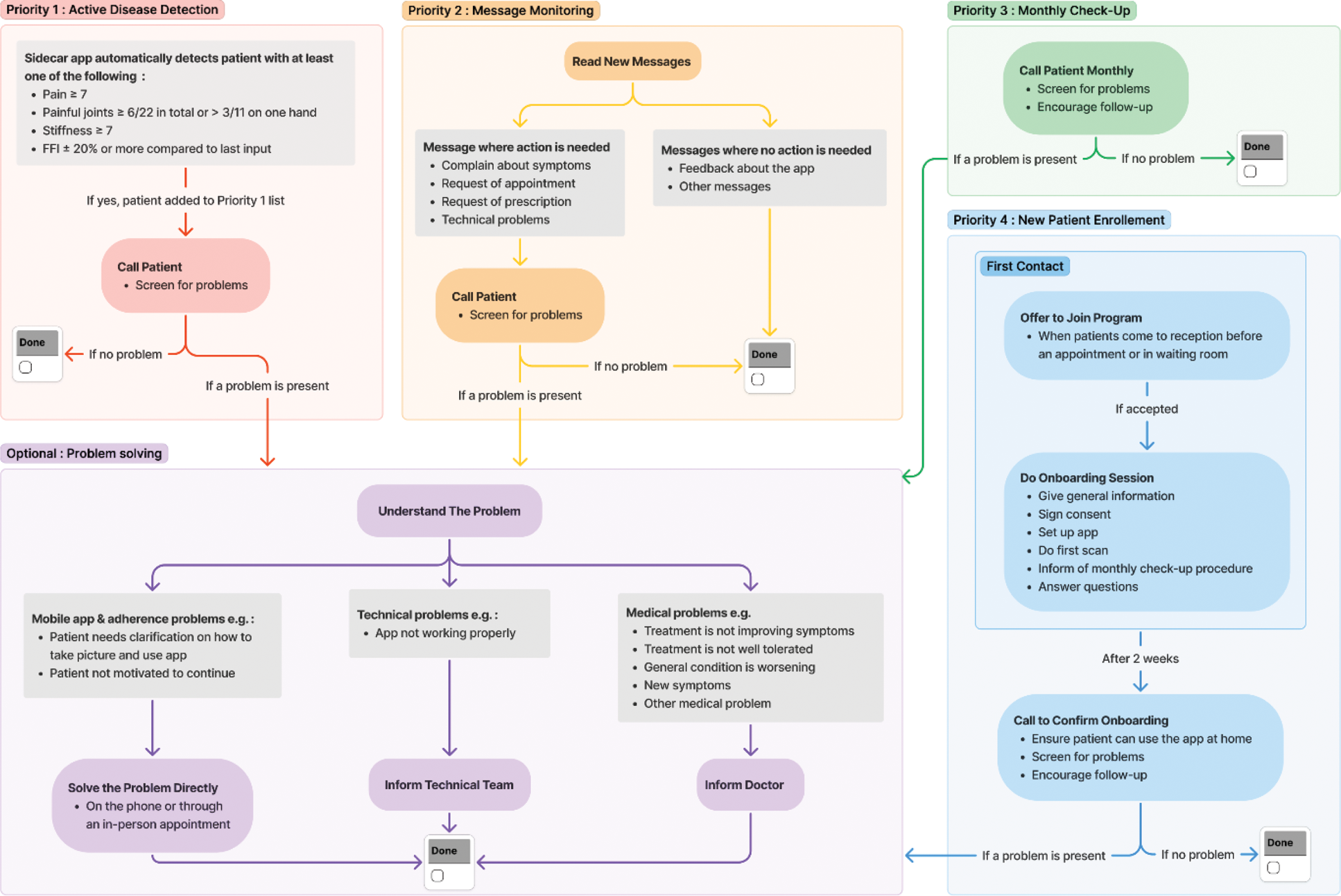

Background: There is a shortage of healthcare providers in rheumatology [1], and better utilization of available resources is required to mitigate this problem. Digitalization of healthcare can simplify workflows and improve productivity. Electronic health records (EHR) are central in the digitalization process as they collect clinical data and facilitate care coordination. However, their lack of specificity for diseases or tasks raises the number of clicks needed to retrieve information or complete tasks. EHR can in fact increase the workload for healthcare professionals. Sidecar applications are deployed alongside the core EHR to enhance its functionality. They are specific and tailorable for certain pathologies and support functions such as remote patient monitoring (RPM) and collection of patients reported outcomes measures (PROMs). They facilitate workflow by reducing clicks, streamline decision making and improve patient outcomes.
Objectives: To develop and implement a multimodal (PROMs & self-photos) EHR sidecar application for monitoring inflammatory arthritis by rheumatologists and health care assistants (HCA). To ensure a user-centered design and assess the application’s usability by conducting qualitative user experience research.
Methods: The DETECTRA dashboard was used for this study, collecting hand photos taken by the patient via a mobile app with PROMs, patient’s comments and doctor’s comments. Photos are presented in a longitudinal scrollable view as either entire hands or cropped peripheral interphalangeal (PIP) joints with painful joints indicated. Photos are automatically cropped to simplify comparison on single joint levels. A machine learning model measures joint diameter and finger fold patterns to monitor joint swelling (Finger Fold Index, FFI [2]). To explore possible improvements in the user interface and functionalities, we developed a new prototype as a sidecar application (Figure 1). The sidecar prototype was created using a design software that allowed interactive exploration to replicate the final application. The prototype was evaluated by rheumatologists (n =9) and HCA (n=3) during semi-structured interviews. Post-interview semantic analyses were done using adapted versions of the User-Centered Design (UCD), Technology Acceptance Model (TAM) and Consolidated Framework for Implementation Research (CFIR) frameworks. In a co-design approach, we improved the prototype after the interviews, developed HCA workflows (Figure 2) and created a remote monitoring office.
Results: During the semi-structured interviews, all doctors considered self-taken photos valuable for synchronous RPM and 89% (8/9) considered PROMs as useful within the sidecar application. 89% (8/9) found the prototype intuitive to use. 67% (6/9) showed interest in using AI for image processing along with image-based digital biomarkers. 33% (3/9) appreciated seeing focused views of joints between two time points rather than only graphs of longitudinal data. When asked in which scenario they would use the application, 56% (5/9) said to identify a patient in active flare needing medical attention, 33% (3/9) during a consultation to discuss results with the patient and 22% (2/9) before seeing a patient to plan the consultation. Concerning enablers to implementation, 89% (8/9) believed a full integration with EHR was crucial and 78% (7/9) suggested the help of HCA to monitor patients. All doctors suggested to extend the application with treatments, 56% (5/9) with inflammatory markers and 33% (3/9) with DAS28. 56% (5/9) proposed adding photos of other joints such as knees or ankles. For HCA interviews, all HCA found the prototype useful and intuitive. When asked about the enablers to implementation, all mentioned allocating a person entirely for RPM, 67% (2/3) wanted a dedicated office and 33% (1/3) needed educational material on RPM. Figure 1 presents the co-designed prototype improved after the interviews. Figure 2 presents the five workflows for HCA. Four ( Active Disease Detection , Message Monitoring , Monthly Check-Up and New Patient Enrolment ) are done daily and ranked by priority. A fifth workflow ( Problem Solving ) is done only in specific cases, as explained below. Each daily workflow is coupled with a patient list (Figure 1D). The HCA goes through each list and calls patients to screen for problems. If no problems are mentioned by the patient, a Done checkbox clears the patient from the list. If a problem is present, the HCA performs the action in the Problem solving workflow to solve the issue.
Conclusion: Co-design is crucial to create useful healthcare sidecar applications and ensure long-term implementation in clinical practice. Self-taken pictures are considered an important element of sidecar applications, notably when synchronous RPM is possible via machine learning models. The adoption of AI by healthcare professionals is encouraging, but more education is needed to integrate it into practice.
DETECTRA Sidecar application prototype. A: Entire hand photos. B: Cropped PIP photos. C: AI-based analyses. D: Healthcare assistants’ patient lists

Healthcare assistants’ workflows. Four daily workflows ranked by priority and the fifth optional workflow for problem solving.

REFERENCES: [1] Miloslavsky EM et al. The Challenge of Addressing the Rheumatology Workforce Shortage. J Rheumatol 2022; Jun; 49 (6) 555-557; doi: 10.3899/jrheum.220300.
[2] Hügle T et al. Dorsal Finger Fold Recognition by Convolutional Neural Networks for the Detection and Monitoring of Joint Swelling in Patients with Rheumatoid Arthritis. Digit Biomark. 2022 Jun; 8;6(2):31-35; doi: 10.1159/000525061.
Acknowledgements: NIL.
Disclosure of Interests: Lorenzo Russo: None declared. Marc Blanchard Atreon, Jules Maglione: None declared. Patrick Hermann Atreon, Cinja Koller: None declared. Thomas Hügle Abbvie, GSK, BMS, Novartis, Lilly, Werfen, Fresenius Kabi, Atreon, Vtuls.
© The Authors 2025. This abstract is an open access article published in Annals of Rheumatic Diseases under the CC BY-NC-ND license (